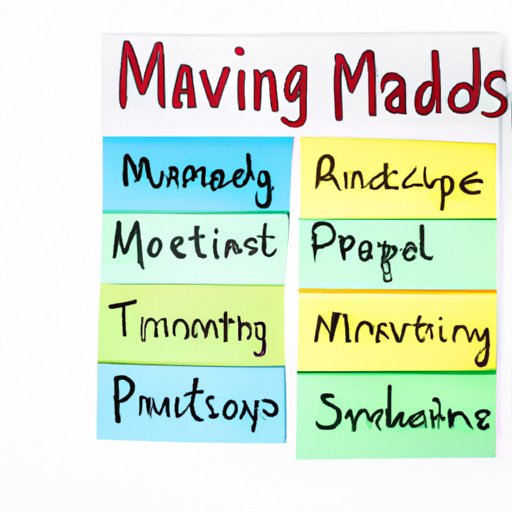Introduction
Are you tired of feeling overwhelmed by the chaos in your mind? Do you struggle to organize your thoughts and ideas? If so, learning how to create mind maps may be just what you need. Mind maps are a visual thinking tool that can help you clarify your thoughts, stimulate your creativity, and achieve your goals. In this article, we’ll dive into the world of mind mapping, explore their benefits, and show you how to create effective mind maps in your daily life.
Beginner’s Guide to Mind Maps
Mind maps are a type of diagram that use a central idea surrounded by connected branches to represent information, ideas, and concepts. The central idea is usually placed in the center of the page, and the branches radiate out like spokes on a wheel. Keywords, images, and colors can be used to enhance the visual impact and help organize the information.
The key components of a mind map include:
- The central idea: The core message or topic of the mind map.
- Branches: These represent the main themes or subtopics that relate to the central idea.
- Keywords: These are short, concise words or phrases used on branches to represent the key concepts, ideas, or thoughts of the specific theme.
The beauty of a mind map is that it allows your brain to make connections between different ideas and concepts, which can lead to a more comprehensive understanding of the subject.
The Power of Mind Mapping
Mind maps have been praised for their ability to boost creativity, improve memory retention, and enhance problem solving skills. By stimulating both the left and right hemispheres of the brain, mind maps can help you see connections and associations that you might have otherwise missed.
While mind maps are generally considered a tool for organizing thoughts and ideas, they can also be used to illustrate a complex process or workflow. They can be especially useful in businesses, education, and personal development, where the ability to break down complex information into manageable parts is crucial.
Mind Maps vs Traditional Note-Taking
Compared to linear note-taking methods, such as outlines or bullet points, mind maps are a more interactive and engaging way to organize information. They provide a more organic and visual way to represent information, which can lead to improved retention and comprehension.
However, it’s important to note that traditional note-taking methods still have their place. They are often more appropriate for taking meeting notes, creating to-do lists, and other practical applications where a more straightforward approach is needed.
How to Use Mind Maps for Better Productivity and Goal Setting
Mind maps can be used in a variety of ways to enhance productivity and achieve goals. For example, dividing a large project into manageable pieces using a mind map can help you stay on track and reduce stress.
Personal goal-setting is another area where mind maps can be helpful. By visualizing your goals in a mind map, you can identify the key steps you need to take and the milestones you need to reach.
To create an effective mind map for productivity or goal setting, start with a clear and concise central idea. Then, identify the main themes or subtopics that relate to the central idea. Use keywords and visual aids to represent the concepts or ideas. Be mindful of the connections between the elements, as this will help you see the bigger picture as well as the specific details.
Mind Mapping Tools and Techniques
There are many different tools and techniques you can use to create mind maps. The simplest method is to use a pen and paper, and let your creativity guide you. Free digital software such as MindNode, MindMeister, or XMind can also provide more precise and structured mind mapping. Some tools offer advanced features such as team collaboration, cloud storage, and presentation mode.
When creating mind maps, it’s important to experiment with different techniques. A mind map is a living thing, and it can evolve as you add new ideas, modify existing branches, or create new relationships between elements. Don’t be afraid to try new things, and remember that there is no ‘right’ way to create a mind map.
Conclusion
By now, you should have a good understanding of what mind maps are, how they work, and what benefits they offer. Remember that mind maps are a versatile tool that can help you organize thoughts, enhance creativity, improve memory retention, and achieve your goals. The key to creating effective mind maps is to experiment and find the approach that works best for you.
